
Dorm
rooms have beds, desks, and shelves, but no TV. English is "team taught"
by a Japanese and native-speaking teacher to give even beginners a feel
for talking in English. Works of art by students are found all over the
campus. Rugby is a school sport, and the high school team has won the
national championship. |
Meikei
High School

Take this virtual tour to see what it's like to spend a day with us
|

|
|
|
The School Day
Classes
Class
1: Team
Teaching (English)
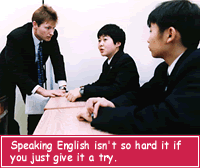 "What
time are you going to get up tomorrow?" "What
time are you going to get up tomorrow?"
As soon as the bell rings to announce the beginning of class, English
teachers Stephen Bird and Yuko Itoyama start up a conversation in English.
Soon, the seventh-grade students notice that the two are using a lot
of expressions of the form "be going to"--the theme of today's lesson.
After this, Mr. Bird walks around the classroom, asking questions. The
students sit tensely, each hoping the teacher doesn't pick on them.
The teaching of English in Japan usually doesn't start until kids enter
middle school.
|
|
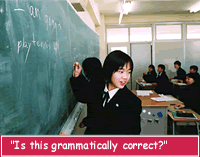 Mr.
Bird: "What are you going to do on Sunday?"
Mr.
Bird: "What are you going to do on Sunday?"
Student: "I'm going to play tennis."
Mr. Bird: "Who are you going to play tennis with?"
The students concentrate on what Mr. Bird is saying so that they don't
miss a word. Seventh graders take this "team teaching" class once a
week, in which a Japanese teacher and a native English-speaking teacher
pair up.
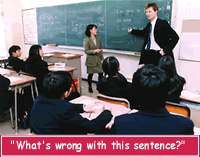 Although the lessons are based on material covered in the textbook,
there's no time during class to take a peek at it. By listening to the
teachers' words and actually saying them, the students gradually get
a feel for talking in English. "It makes me nervous, because I don't
know when I'll be called," comments one student. "It's thrilling and
fun," says another. The 50-minute class goes by in a flash for the students,
who like the class very much.
Although the lessons are based on material covered in the textbook,
there's no time during class to take a peek at it. By listening to the
teachers' words and actually saying them, the students gradually get
a feel for talking in English. "It makes me nervous, because I don't
know when I'll be called," comments one student. "It's thrilling and
fun," says another. The 50-minute class goes by in a flash for the students,
who like the class very much.
|
| Class
2:
Art
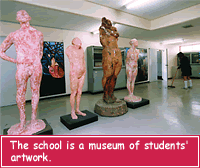 Paintings,
sculptures, and other artwork by the students can be found all over
the campus, from the hallways to the courtyard. "A work is not completed
when one finishes making it. Only after it's displayed and communication
begins between it and the viewers does it becomes a genuine work of
art." So says Koichi Furuyama, the school's art teacher, explaining
the thinking behind the exhibit-oriented education of the school. Paintings,
sculptures, and other artwork by the students can be found all over
the campus, from the hallways to the courtyard. "A work is not completed
when one finishes making it. Only after it's displayed and communication
begins between it and the viewers does it becomes a genuine work of
art." So says Koichi Furuyama, the school's art teacher, explaining
the thinking behind the exhibit-oriented education of the school.
|




|
|
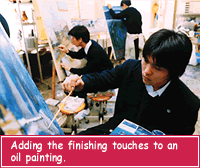 Inside the art studio, several
eleventh graders who are taking the oil painting elective are working
on a big project they have to complete by the end of the school year.
Most of them have chosen to create collages or abstract works. The work
must be at least 70 by 100 centimeters (28 by 39 inches): One student
has put four wooden boards together to make an extra-large canvas.
Inside the art studio, several
eleventh graders who are taking the oil painting elective are working
on a big project they have to complete by the end of the school year.
Most of them have chosen to create collages or abstract works. The work
must be at least 70 by 100 centimeters (28 by 39 inches): One student
has put four wooden boards together to make an extra-large canvas.
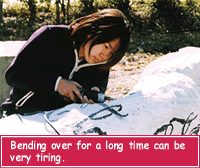 Students
enrolled in the stone sculpture elective, meanwhile, are carving chunks
of a porous rock 90 centimeters (35 inches) high with chisel and hammer.
One girl, whose theme is "candle," says cheerfully, "It's hard making
a pillar shape. Sometimes I'd carve off too much, and once in a while
I'd accidentally hit my hand with the hammer, so I'm bruised all over." Students
enrolled in the stone sculpture elective, meanwhile, are carving chunks
of a porous rock 90 centimeters (35 inches) high with chisel and hammer.
One girl, whose theme is "candle," says cheerfully, "It's hard making
a pillar shape. Sometimes I'd carve off too much, and once in a while
I'd accidentally hit my hand with the hammer, so I'm bruised all over."
=> Club
Activities
|
Send
your comments and questions here
([email protected]).

|



 "What
time are you going to get up tomorrow?"
"What
time are you going to get up tomorrow?" Mr.
Bird: "What are you going to do on Sunday?"
Mr.
Bird: "What are you going to do on Sunday?" Although the lessons are based on material covered in the textbook,
there's no time during class to take a peek at it. By listening to the
teachers' words and actually saying them, the students gradually get
a feel for talking in English. "It makes me nervous, because I don't
know when I'll be called," comments one student. "It's thrilling and
fun," says another. The 50-minute class goes by in a flash for the students,
who like the class very much.
Although the lessons are based on material covered in the textbook,
there's no time during class to take a peek at it. By listening to the
teachers' words and actually saying them, the students gradually get
a feel for talking in English. "It makes me nervous, because I don't
know when I'll be called," comments one student. "It's thrilling and
fun," says another. The 50-minute class goes by in a flash for the students,
who like the class very much.  Paintings,
sculptures, and other artwork by the students can be found all over
the campus, from the hallways to the courtyard. "A work is not completed
when one finishes making it. Only after it's displayed and communication
begins between it and the viewers does it becomes a genuine work of
art." So says Koichi Furuyama, the school's art teacher, explaining
the thinking behind the exhibit-oriented education of the school.
Paintings,
sculptures, and other artwork by the students can be found all over
the campus, from the hallways to the courtyard. "A work is not completed
when one finishes making it. Only after it's displayed and communication
begins between it and the viewers does it becomes a genuine work of
art." So says Koichi Furuyama, the school's art teacher, explaining
the thinking behind the exhibit-oriented education of the school.
 Inside the art studio, several
eleventh graders who are taking the oil painting elective are working
on a big project they have to complete by the end of the school year.
Most of them have chosen to create collages or abstract works. The work
must be at least 70 by 100 centimeters (28 by 39 inches): One student
has put four wooden boards together to make an extra-large canvas.
Inside the art studio, several
eleventh graders who are taking the oil painting elective are working
on a big project they have to complete by the end of the school year.
Most of them have chosen to create collages or abstract works. The work
must be at least 70 by 100 centimeters (28 by 39 inches): One student
has put four wooden boards together to make an extra-large canvas.  Students
enrolled in the stone sculpture elective, meanwhile, are carving chunks
of a porous rock 90 centimeters (35 inches) high with chisel and hammer.
One girl, whose theme is "candle," says cheerfully, "It's hard making
a pillar shape. Sometimes I'd carve off too much, and once in a while
I'd accidentally hit my hand with the hammer, so I'm bruised all over."
Students
enrolled in the stone sculpture elective, meanwhile, are carving chunks
of a porous rock 90 centimeters (35 inches) high with chisel and hammer.
One girl, whose theme is "candle," says cheerfully, "It's hard making
a pillar shape. Sometimes I'd carve off too much, and once in a while
I'd accidentally hit my hand with the hammer, so I'm bruised all over."